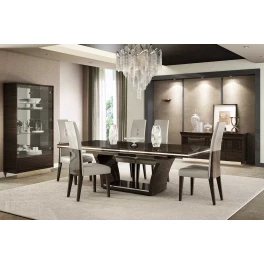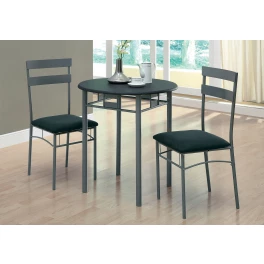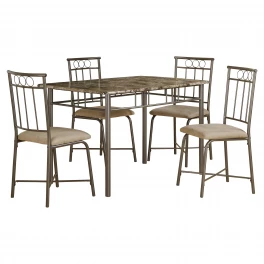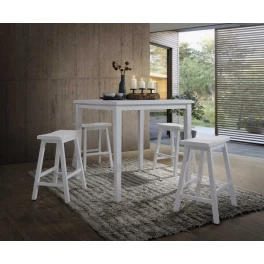There’s something about a neoclassical dining room that seems to appeal to a broad range of tastes. Who doesn’t love divine cherry wood tables and luxurious-looking vases, candles, and paintings? It pays homage to a bygone era when people dressed up for formal events, hosted tea parties and luncheons, and ate a three-course dinner together as a family every night. The neoclassical period started in the 18th century (and was carried well into the 19th and 20th centuries), and was inspired by the art and architectural style of Roman and Greek populations.
Symmetry, balance, and clean lines are hallmark elements of this design style, with décor that includes large arched entryways, garlands, swag valances, decorative molding, freestanding columns, marble statues, elegant vases, still-life paintings, and rich fabric patterns with muted colors. While this design is three centuries old, it can still be beautifully implemented into 21st century homes by modifying some of these elements to give it a modern twist.
If you’re looking for that stately and elegant design style without creating a “just look, but don’t touch” museum-like environment, then this neoclassical dining room with a contemporary undertone is the perfect way to get that look. Here are five aspects that will help you achieve your vision. (Don’t forget to test out your design plans in House Tipster’s 3D Virtual Rooms.)
1. A Vintage Dining Set
Whether it’s truly vintage or vintage-inspired, a key part of furnishing the room is to find tables, chairs, and buffets that are representative of the neoclassical era since everything will be centered around it. This beautiful Duncan Fyfe style dining room set was advertised in a Penny Saver ad waiting to be rehomed, and it’s the perfect foundation for the dining room. Duncan Fyfe was a 19th century cabinet and furniture maker, and his luxurious designs were inspired by the neoclassical style of symmetry, clean lines, and gentle curves.
After his death, his original furniture collections went to the wayside, but there are still several original pieces that are around today (but they’re so rare, that they’re worth anywhere from $4,000 to $28,000. Yikes!). His unique design style was later revived in the 1920s when other furniture companies made replicas of his original works. The dining set pictured here is a Duncan Fyfe replica that was manufactured in the 1940s, and even though it’s not an original, it’s still a vintage piece that delivers incredible charm and character to the dining area.
2. Crown Molding and Wainscoting
Instead of columns and pillars (the design inspiration from the Greeks and Romans), crown molding and wainscoting can add a modern, finished look without being over-the-top ornate. The crown molding and wainscoting in this dining room adhere to the neoclassical style of clean lines, symmetry, and balance without looking like a Roman temple.
The windows are framed in a similar fashion and don’t have any large swags or valances hanging from the top. Even though heavy swags were a staple of the neoclassical design style, this is one of the elements that can either be toned down or left out altogether in order to infuse a modern touch to the room and prevent it from looking gaudy.
3. An Intricate Area Rug
Since the walls are beige with white crown molding and wainscoting, an intricate design with beautiful earth-tone colors can create a stunning contrast against the dark hardwood floors and neutral walls. Choose a traditional pattern (avoid contemporary chevron or geometric patterns) since your modern touches are around the perimeter of the room.
Make sure that the rug is large enough to cover a surface area that will accommodate your entire dining set even when the chairs are being occupied and are a little further out from the table. This long rectangular area rug is the perfect fit, and makes a statement all on its own.
4. Sophisticated Décor
When creating a neoclassical dining room, choosing warm earth tones is always a safe bet, and the colors can be inspired by traditional still-life art inspirations, such as the fruits, flowers, and plants in the main painting above the buffet. Adding touches of gold also gives the room an ornate feel without drowning the room in jewel tones.
Embellished vases, traditional candle sticks, ornate table lamps, and unique dishes pay tribute to the neoclassical era, and provide a stately design for the focal point of the main wall.
5. Statement-Piece Lighting
Instead of a traditional chandelier draped in crystal, you can implement a modern light fixture to help bridge the neoclassical time period with the 21st century. This light fixture replicates the gentle curves in the shield-back dining room chairs, and matches the dark tones of the picture frames on either side of the buffet as well as the white tones from the crown molding and wainscoting.
It’s the perfect way to implement an elegant touch while maintaining a down-to-earth atmosphere. A dimmer switch also creates the perfect ambience for warm, soft lighting for those classy dinner parties that you’ll be hosting (since your house will be the new favorite hot spot).
What’s your favorite design element from the neoclassical interior design style? Would you add a large swag above the windows or keep it simple? Share your thoughts in the comments below!


























